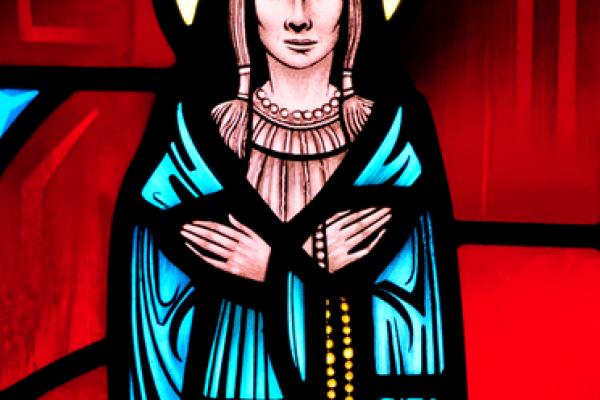MOHAWK VALLEY, New York — Twelve-year-old Jake Finkbonner leaned over and ran his hand through a pool of water from a natural spring at the National Shrine of Blessed Kateri Tekakwitha, in Fonda, N.Y.. With that simple gesture, on a recent July weekend, the boy connected literally to the story of the 17th-century Native American woman who the Roman Catholic Church will elevate to sainthood on Oct. 21.
Jake had already connected to her story in what he believes is a miraculous way. The boy's inexplicable recovery from a flesh-eating illness in 2006 is attributed to prayers to Kateri (pronounced Gad-a-lee in Mohawk) on his behalf.
Jake, who is of Lummi descent, said he's gotten used to the attention he draws when people learn he's at the center of the miracle that led the Vatican to decide to proclaim Kateri a saint — a step that will make her one of the church's holy role models, and the first Native American to be canonized.
He likes to read and play basketball, and he loves video games. He and his 10-year-old sister, Miranda, are also training to become altar servers.
"I feel a great amount of gratitude and thanks to her," Jake said of Kateri.
The spring in upstate New York is believed to be where Kateri Tekakwitha was baptized and formally became a Christian on Easter Sunday in 1676. That spring water supplied the Mohawk village where Kateri lived for 11 years. Jake and his family filled several bottles with water from the spring to take back to their Ferndale, Wash., home.
The Finkbonners were among hundreds of people visiting the Kateri shrine and the Shrine of Our Lady of Martyrs, in Auriesville, N.Y., as part of the 73rd Annual Tekakwitha Conference that took place in mid-July in nearby Albany.
The Tekakwitha Conference is based in Great Falls, Mont., and is the only Catholic Native American/Aboriginal religious organization in North America. An estimated 680,000 Native American Catholics live in the United States, according to the U.S. Conference of Catholic Bishops.
In addition to an annual conference, the group sponsors dozens of local Native Catholic groups, known as Kateri Circles. The conference's theme this year was "Walking in Her Footsteps in Kateri Country."
Kateri was born in 1656 to a Mohawk father and an Algonquin/Christian mother in a Mohawk village in what is now Auriesville. (It was then called Ossernon.) When she was 4, a smallpox epidemic killed her parents and younger brother. The illness left her with scars, and she was nearly blind for the rest of her life. Her uncle, who was hostile to Christianity, cared for the orphan. He paired her with an Iroquois boy she was expected to marry. But Kateri rejected efforts to marry her off, and she committed herself to Christ.
She died in 1680 at age 24 in Canada, where she fled to a Native/Christian community a few years earlier to escape harassment by Iroquois who disapproved of her conversion. Her remains are entombed in a church near Montreal.
Catholics honor Kateri because of her commitment to the church despite being ridiculed and ostracized.
The Auriesville shrine is also dedicated to three French Jesuit missionaries (the most well known is Isaac Jogues) who were killed by Mohawks in the 1640s. The Catholic Church considers the missionaries martyrs because they died in defense of their faith.
The shrines are a few miles apart, and buses transported many of the 800 conference attendees to the expansive sites in the Mohawk Valley. Statues of Kateri and other holy Catholic figures dot the grounds of both shrines. At the Kateri shrine, pilgrims climbed a hill to the original site of the 17th-century Mohawk village, then called Caughnawagha. The borders of the village are marked with different color poles, which depict a series of archaeological excavations that began in 1943.
The shrines house museums full of Iroquois artifacts, such as pottery, baskets and pipes, as well as other items associated with Native American culture. A chapel at Auriesville displays a relic of Kateri -- a tiny bone fragment.
Just inside what would have been a fortification wall for Caughnawagha, Steve Senter, of Lapwai, Idaho, knelt and filled a tiny plastic bag with dirt. He plans to bring it home to a friend on the Nez Perce Reservation.
"It's part of the earth where she walked," he said. "It's kind of sacred."
Mary McNamara, who lives in Fultonville, N.Y., has attended Mass at Auriesville during summers since 1980. She's devoted to Kateri.
"She had total dedication. No matter what pressure was put on her to marry or whatever, she had already consecrated her life to Jesus," she said. "I pray to her that I may have some of that."
Syracuse Bishop Robert J. Cunningham celebrated afternoon Mass for the pilgrims in a huge circular chapel, called the Coliseum Church. In his homily he noted that Tekakwitha means the "one who walks groping her way." While this description refers to Kateri's impaired eyesight, it is also a message to Christians struggling to live the Gospel, he said.
"The simplicity of her life, the depth of her faith and her dedication to those in need continue to inspire those of us still groping in the ways o f faith," Cunningham said.
The Revs. William Shaw and John Shaw, who are brothers, traveled from White Swan, Wash., near Spokane for the Tekakwitha Conference. The two minister on the Yakama Reservation, which consists of 10,000 Natives, a tenth of whom are Catholic. They see no conflict between Native American traditions and Catholicism.
"They fit together," William Shaw said.
Renee K. Gadoua writes for The Post Standard in Syracuse, N.Y. Via RNS.
Image: Stained glass window panel of Blessed Kateri Tekakwitha, a Mohawk Indian who will be canonized a saint by the Roman Catholic Church in October. Photo by Nancy Bauer/ Shutterstock.
Got something to say about what you're reading? We value your feedback!
